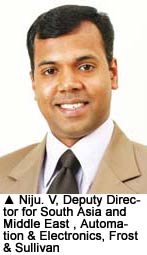Making day-to-day commuting easier and safer is a widespread concern. The global market for intelligent transportation system (ITS) will grow at 11 percent in 2009 and 2010, and is expected to grow at 10 percent each year from 2010 to 2015, said Pascal Lemonnier, ITS Business Development Manager, CS Group.
Making day-to-day commuting easier and safer is a widespread concern. The global market for intelligent transportation system (ITS) will grow at 11 percent in 2009 and 2010, and is expected to grow at 10 percent each year from 2010 to 2015, said Pascal Lemonnier, ITS Business Development Manager, CS Group.
The market continues to expand. Roland Hooghiemstra, VP of Global Sales and Support at Optelecom-NKF, cited IMS Research's 2009 prediction for IP traffic monitoring to average 27 percent growth annually. "However, growth has decelerated to 19 percent due to the economic downturn," he said.
The Middle East and Asia provide opportunities to start from the scratch. "Only a few cities have commissioned integrated systems in India, and existing systems are being expanded to include more intelligent technologies," said Niju. V, Deputy Director for South Asia and Middle East, Automation and Electronics, Frost & Sullivan.
"Taking on new developments is easier than delivering systems from the bottom up," said Jim Dixon, Managing and International Director for the U.K., Egis Mobilite. "It is possible to developing foundations that can be built upon rather than engineer solutions to meet compromises."
Popular Applications
Video monitoring is a core system for timely traffic management. "There are no regulations in terms of video recording," said Danny Peleg, Director of Transportation Market, Genetec. "In ITS, video is not recorded for liability reasons but used for live viewing of incident management. High resolution and high frame rate are required for immediate intervention."
Traffic authorities are reluctant to accumulate video footage as it may expose them to liability claims, said Peter De Konink, Product Line Manager of Codecs and Analytics, Optelecom-NKF.
"Strategically placed detection cameras, usually fixed, at traffic junctions and along expressways aim for data collection, whereas surveillance cameras are mainly employed for verification purposes with PTZ control," said Lau Thiam Beng, President of ST Electronics (Info-Comm Systems).
High-resolution, real-time monitoring coupled with MPEG-2 compression and event-driven recording is most commonly used, De Konink added.
Intelligence with video analytics and license plate recognition (LPR) is in demand to reduce congestion and aid law enforcement. Video analytics is used primarily for car counting, vehicle classification and road monitoring. "This information helps to better manage highway traffic and provide statistics on road usage and deterioration rate for future infrastructure planning," Peleg said. Data produced from LPR helps calculate delays and volume.
Enhancing revenue control and reporting capabilities is gaining traction. LPR enables free-flow tolling, speed and red-light enforcement, while video analytics can spot U-turn violations, Peleg said.
Another growing intelligent application is automatic incident detection (AID). "Regulations and directives have dictated that tunnels of a certain length, require higher safety standards, which has put AID in high demand," De Konink said.
By automatically alerting operators to traffic disruptions, AID enables fast remedial action. "Virtual loops can be configured based on images from the detection  cameras, which are less costly to build compared to conventional magnetic loops," Lau said. Increased uptake is seen for highways, express lanes, carpool lanes and hard shoulders.
cameras, which are less costly to build compared to conventional magnetic loops," Lau said. Increased uptake is seen for highways, express lanes, carpool lanes and hard shoulders.
However, high false alarm rates from video analytics demands further improvement. Algorithms should be tailored to meet specific transportation needs.
Future Trends
Improving traffic management and reducing pollution have been major market drivers, Lemonnier said. The smart traffic systems of tomorrow are moving in two directions: Fortifying integration and promoting intelligent use of technologies for the user.
As good passenger transport become more integrated worldwide, system planning must oversee road traffic and allow control centers to manage multiple forms of transportation. "The traditional isolated system has gradually developed into intermodel transportation systems," said Cees De Wijs, Global Director for Transport and Logistics at Logica.
"There is an apparent disengagement of commuters in terms of using transportation infrastructure," noted Riz Khaliq, Global Business Unit Executive, IBM Global Government, IBM. "In the U.S., people spend on average five days a year sitting in traffic, producing carbon emissions." Enabling commuters to proactively make decisions with transportation information will be a focus of ITS development.
Susheela Venkataraman, Director IBSG, India and SAARC, Cisco Systems, seconded the idea of mobility not only for transportation but to bring people and information together. "The expectations of commuters have risen considerably due to the increased availability of information," Venkataraman said. A strong service platform that allows users to pull up relevant information as required is a must.